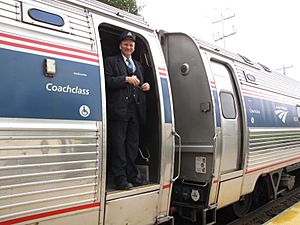Conductor (rail) facts for kids

A conductor (in North America) or guard (in places like the UK) is a very important person on a train. They are part of the train crew. Their main job is to make sure the train runs safely and on time. They don't drive the train, but they are in charge of many other important tasks.
The conductor's job is common all over the world, but the name changes. For example, in some countries, they might be called a train manager.
- Making sure the train follows all safety rules.
- Helping the train stay on schedule.
- Opening and closing the train doors.
- Checking tickets and helping passengers.
- Making sure train cars and cargo are picked up and dropped off correctly.
- Filling out important papers during the trip.
- Guiding the train when it moves backward.
- Connecting or disconnecting train cars.
- Helping to move train cars around the yard.
Some public transport systems, like subways, also have conductors. These conductors might make announcements and open or close doors. They often stand in the middle of the train to see the platform better. Even though many systems use computers to run trains, some still have conductors. This includes the New York City Subway and Toronto Transit Commission.
Conductors also work on some buses, trolleybuses, or trams.
Contents
What Does a Train Conductor Do?
Conductors on North American Trains
In North America, the conductor is in charge of a freight (cargo) or passenger train. They lead the train crew. This crew can include people like a brakeman, flagman, or assistant conductor. The conductor is responsible for how the train moves. The engineer, who drives the train, takes directions from the conductor.
The conductor works with the engineer and the dispatcher (who manages train movements from an office). They make sure the train has permission to move and does not go past its allowed area.
Daily Tasks of a Conductor
Conductors have many important tasks every day:
- They talk and work with other railway staff, like yardmasters and dispatchers.
- They watch for signals, the position of switches, and other things that affect train safety.
- They check the train cars for any mechanical problems.
- They help the engineer test the train's air brakes.
- They signal the engineer when to start or stop the train.
- They keep a logbook of the journey.
- On passenger trains, they check tickets and collect fares.
- They keep records of what cargo is on the train.
- They direct and often help with moving train cars around (called shunting or switching).
Assistant Conductors and Crew Changes
Passenger trains might have one or more assistant conductors. These assistants help the main conductor and engineer. They share the work and take on some responsibilities. If a train trip is very long, more than one crew might be assigned. This helps make sure everyone gets enough rest.
How Train Crews Have Changed
For a long time, freight train conductors in North America rode in a special car called a caboose. This car was at the very end of the train. Other crew members, like the rear flagman and brakeman, also rode there.
Over time, new technology made cabooses less needed. Also, railway companies wanted to save money. So, most cabooses were removed. This meant the conductor moved from the back of the train to the front, with the locomotives. Many other crew members, like head brakemen, were also no longer needed.
Today, most freight trains usually have two crew members: an engineer and a conductor. Railway companies sometimes try to reduce this to just one person. They say that engineers are already trained as conductors. However, unions (groups that protect workers' rights) often have agreements that require both an engineer and a conductor. The union for engineers believes that operating trains alone would not be safe.
Images for kids
-
A streetcar conductor in 1919 in Flint, Michigan.






